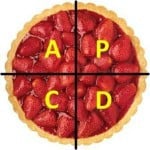 Mark's Note: Today's guest post comes from Mark Hamel, a recent recipient of the Shingo Research and Professional Publication Award for his book Kaizen Event Fieldbook: Foundation, Framework, and Standard Work for Effective Events. Mark has been blogging at his site, Gemba Tales, and he's been doing some work in the healthcare realm, as well.
Mark's Note: Today's guest post comes from Mark Hamel, a recent recipient of the Shingo Research and Professional Publication Award for his book Kaizen Event Fieldbook: Foundation, Framework, and Standard Work for Effective Events. Mark has been blogging at his site, Gemba Tales, and he's been doing some work in the healthcare realm, as well.
Keep coming back the rest of this month for a set of diverse guest blogging voices… and now to Mark Hamel's post:
“Do” Only Gets You Half the Way There, or…”No Pie for You!”
 Most of us have seen and used the “status pie.” It's that circle that looks a bit like the view through a rifle telescope – with the crosshairs yielding four equal sized pieces of pie. The pie is typically on the rightmost side of the what, who and when portions of the countermeasure form or kaizen newspaper. It provides a quick, low tech, visual way of tracking the status of assigned actions. Heck, during a kaizen event, you can even use a different color each day so that you can better discern daily progress…or the lack thereof.
Most of us have seen and used the “status pie.” It's that circle that looks a bit like the view through a rifle telescope – with the crosshairs yielding four equal sized pieces of pie. The pie is typically on the rightmost side of the what, who and when portions of the countermeasure form or kaizen newspaper. It provides a quick, low tech, visual way of tracking the status of assigned actions. Heck, during a kaizen event, you can even use a different color each day so that you can better discern daily progress…or the lack thereof.
Now, a lot of people misjudge how to award pie portions. Often it's because they aren't thinking PDCA, they're thinking how much of the action step/countermeasure did I “do”? They think the pie is a “Do Pie” and the pieces of the pie are 25%, 50%, 75% and 100% DONE.
Getting pieces of pie is gratifying and completing the pie is really gratifying. But we need to educate folks on what the pies mean and more importantly how to think PDCA.
How do we educate? Remember Seinfeld's Soup Nazi? “No soup for you!” Well, this is where you need to be a Pie Nazi. “No pie for you!” …or at least, “Only an 1/8 for you!”
For example, if a sub-team is working the countermeasure “implement standard work for process ‘A',” they get the following pieces of pie when they:
- Plan. Understand and acknowledge the task, its scope, have conducted time observations, % load analysis, etc ., and have identified the waste and opportunities.
- Do. Trystormed and implemented improvements, developed the supporting standard worksheets and standard work combination sheets, trained the workers to the new standard work and posted it within the work station.
- Check. Run to the new standard work for a number of hours, across different shifts while directly observing and measuring, etc.
- Act. Make necessary adjustments (often in real time) based upon the lessons learned from the “Check” phase.
Now, most folks would demand a full pie as soon as they cobbled together some standard work sheets and standard combination sheets. Come on, admit it. And, how many times have you developed standard work and it was acceptable right out of the gate? “Never,” is my answer.
So, as we continue our own PDCA learning and awareness journey, pie will not be served buffet style. We must do this to avoid the risk of overindulgence. Folks will often self-award more pieces of pie than they really deserve. That's why we need the Pie Nazi – played by either a facilitator, team leader or the like to keep us honest and help us live PDCA. Enjoy your pie!
Mark R. Hamel, a senior lean six sigma implementation consultant, shares his humble insights on lean at Gemba Tales and is the author of the Society of Manufacturing Engineers published and Shingo Prize Research and Professional Publications Award winning Kaizen Event Fieldbook: Foundation, Framework, and Standard Work for Effective Events. He can be reached at mark, over at kaizenfieldbook dot com.
Please scroll down (or click) to post a comment. Connect with me on LinkedIn.
Let’s build a culture of continuous improvement and psychological safety—together. If you're a leader aiming for lasting change (not just more projects), I help organizations:
- Engage people at all levels in sustainable improvement
- Shift from fear of mistakes to learning from them
- Apply Lean thinking in practical, people-centered ways
Interested in coaching or a keynote talk? Let’s talk.
Join me for a Lean Healthcare Accelerator Trip to Japan! Learn More










Mark, you bring a perspective of the pie that I have not thought of before. You are absolutely right. I have also completed the pie when the standardized work or action was completed and not when it was tested and adjusted. I like your perspective on the pie. The method you outlined would help to hammer home the PDCA method to the lowest level of problem solver.
Has it helped sustain results in your experience? Do people get frustrated at first because they want the pie as quickly as possible?
“pie will not be served buffet style” – I love it. Outstanding post and a great reminder as a facilitator that we are teaching the FULL PDCA wheel and not just rewarding people for getting the DO part done in an event!
…no Nazis. How about “pie czar” instead?
Hi Matt,
Thanks for the comment!
I am purposefully very stingy about handing out slices and I know that I tick off a lot of folks…at least until they start understanding PDCA more deeply. The “ticking off” part really helps create some teachable moments for the owner(s) of the task as well as the other folks on the team who just think I’m being a capricious sort.
I am convinced that the PDCA pie technique helps drive more sustainable and effective countermeasures. Most importantly, it helps develop more scientific thinkers and better follow-through.
Best regards,
Mark Hamel
Comments are closed.